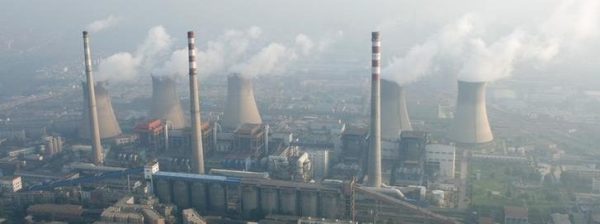Will LNG save China from winter gas shortage and boost global LNG prices?

An aerial view shows a coal-burning power plant on the outskirts of Zhengzhou, Henan province, China, Aug. 28, 2010. REUTERS/Stringer/File Photo
Colder-than-normal end of winter could further boost local LNG demand, and global LNG price
China’s introduction of the ‘2+26’ cities policy earlier this year calls for restricted use of coal for both residential heating and industrial purposes. This has significant ramifications for the Chinese winter season where demand is traditionally high, according to Wood Mackenzie.
As an alternative to coal, gas demand could rise by 23 bcm (billion cubic metres) this year compared to previous winters.
Facing the most severe shortages is northern China, particularly Beijing, Tianjin and Hebei (abbreviated as BTH), where demand is highly seasonal. This region will make up half or 10 bcm of the incremental winter gas demand in 2017.
To meet this demand increase, the BTH region has several options. BTH relies heavily on inbound piped-gas from other provinces, and for that, the Shaan-Jing pipelines form the backbone for the region, according to Wood Mackenzie.
During the coldest months, BTH can also tap on gas storage. CNPC operates four underground storage facilities in Tianjin and Hebei, and there is also a small amount of indigenous production from Bohai Bay and Dagang.
However, there are challenges to using piped-gas and domestic production. The ramp-up schedule of Shaan-Jing IV pipeline remains uncertain.
Also, it is unclear whether there will be sufficient gas from domestic gas fields or piped imports to feed into the Shaan-Jing pipelines.
In the past, Wood Mackenzie has seen CNPC sacrifice gas-producing regions’ demand to guarantee gas demand in the capital areas.
Amid the large pipeline capacity jump this year, whether CNPC can continue to do so and balance regional interest is another risk.
LNG imports then become the next viable solution. There are two operating terminals located in BTH – CNPC’s Caofeidian terminal and CNOOC’s Tianjin terminal.
Caofeidian was operating beyond working capacity from Dec. 2016 to Jan. 2017. But in other months, it still has room to ramp up imports.
Tianjin terminal was largely under-utilised last winter due to relatively weak demand growth, running at 20 per cent in most winter months and 50 per cent in Dec.
Sinopec is constructing another terminal in Tianjin, but due to construction delays, it is not possible to serve the winter demand.
Trucked LNG is flexible and can also address infrastructure constraints. However, affordability is a factor to consider.
Our supply-demand balance analysis shows that shortages on a large scale could be avoided if all supply sources and infrastructure are running perfectly, however, daily shortage will almost certainly happen if there are cold snaps.
Hebei province is also very likely to experience a gas shortage if PetroChina does not allow Hebei to increase its gas download from the trunk lines.
Looking at the national level, China’s LNG imports will total 20 Mt this winter, up by 40 per cent year-on-year. But compared to last winter, there will be more reliance on spot purchases, according to Wood Mackenzie.
The higher-than-usual demand throughout 2017 resulted in higher offtake in contracted LNG volumes in Jan. to Sept.
PetroChina had imported around 70 per cent of its annual contract quantity (ACQ) by Sept., while it had only imported around 50 per cent of its ACQ between Jan. and Sept. 2016. This means lower contracted offtake is left for the winter, and higher demand for spot.
China’s winter LNG demand will affect LNG import prices. Regas capacity constraints in northern China might limit LNG price upside in Dec. and Jan. But a colder-than-normal end of winter could further boost local LNG demand, and global LNG price.








